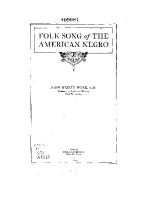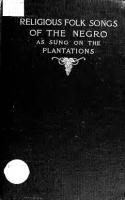Folk Saints in The Folk Catholicism of The Americas [PDF]
Folk Saints in the folk Catholicism of the Americas Folk saints are deceased people or other spiritually powerful entit
41 1 3MB
Papiere empfehlen
![Folk Saints in The Folk Catholicism of The Americas [PDF]](https://vdoc.tips/img/200x200/folk-saints-in-the-folk-catholicism-of-the-americas.jpg)
- Author / Uploaded
- Angela Natel
Datei wird geladen, bitte warten...
Zitiervorschau
Folk Saints in the folk Catholicism of the Americas Folk saints are deceased people or other spiritually powerful entities (such as Indigenous and African spirits) venerated as saints, even if they’re not officially canonized by the Church. This map uses a more expanded definition, which does include some canonized saints with major popular admiration in the continent. La Difunta Correa is a figure in Argentinian and Chilean folk-religion. Every year since 1840, miracles are said to occur at the shrine. Her body was found by gauchos, astonished when they saw the dead woman’s baby was alive, feeding from her “miraculously” ever-full breast.
On October 8, 1967, the Argentine revolutionary Che Guevara was captured by the CIA-assisted Bolivian Army and killed, nowadays a monument to “El Che” exists in the town and images of the revolutionary are hung, and some pray to Santo Ernesto who is said to bring about miracles.
Padre Cícero was a Brazilian Catholic priest who became a spiritual leader to the people of Northeastern Brazil. In the course of his ministry, he was accused of heresy by the Church, eventually becoming suspended but not formally excommunicated. A statue of him now stands.
Santa Muerte is an idol, female deity or folk saint in Mexican folk Catholicism and paganism. A personification of death, she is associated with healing, protection, and safe delivery to the afterlife by her devotees. She is seen as a protector of outcasts, including LGBT people.
Gauchito Gil is a folk religious figure in Argentina’s popular culture. One can spot small shrines of Gauchito Gil on roadsides throughout Argentina due to the red color and the flags, many of which read “Gracias, Gauchito Gil” if the person’s request is fulfilled.
Escrava Anastacia is a popular saint venerated in Brazil. A Black slave woman, Anastacia is depicted as beautiful, having piercing eyes and wearing an oppressive facemask. Anastacia is a very important figure in Folk Catholic and Umbanda devotion, especially with Black Brazilians
Maximón, also called San Simón, is a Mayan deity and folk saint represented in various forms by the Maya people of several towns in the highlands of Western Guatemala. Oral tradition of his in these communities is complex, diverse, and born of the Maya traditions centuries ago.
El Niño Fidencio was a Mexican curandero. Fidencio was famous for operations without anaesthesia without causing pain to patients, and provided cures related to specific parts of town, such as a pepper tree which the congregation threw offerings around. He is now seen as a saint.
In Puerto Rico, Dia de Los Tres Reyes Magos, or Three Kings’ Day is an important holiday. On the day before the feast (January 5), the “Rosario de Reyes”
or “Promesa de Reyes” is traditionally celebrated with songs (aguinaldos) promised to be sung to the Kings.
Jesús Malverde, known as the “angel of the poor”, or the “narco-saint”, is a folklore hero in the Mexican state of Sinaloa. He is a “Robin Hood figure” who was supposed to have stolen from the rich to give to the poor. He is celebrated as a folk saint, particularly among narcos.
Mariana of Jesus de Paredes is a Catholic saint and was the first person to be canonized from what is now Ecuador. She was a recluse who is said to have sacrificed herself for the salvation of her city. She remains very popular with many of the people of Ecuador.
Miriam Alejandra Bianchi, known by her stage name Gilda, was an Argentinian cumbia singer and songwriter. On 7 September 1996 Gilda died in a tragic bus accident, and shortly after her death, Gilda was credited by her fans with achieving miracles and many even called her a saint.
Sarita Colonia, or La Sarita, was a young Peruvian woman who was credited with the ability to make miracles. After her death, a popular veneration for her began,
due to her reputation of holiness. She is not recognized by the Church, but is popular, especially with the poor.
Charlene Marie Richard was a twelve-year-old Catholic Cajun girl from Richard, Louisiana, USA. She has become the focus of a popular belief that she is a saint— a person who is in heaven—who has performed a number of miracles.
El Tío, is believed in Cerro Rico, Potosí, Bolivia to be the “Lord of the Underworld”. There are many statues of this spirit in the mines of Cerro Rico. He rules over the mines, simultaneously offering protection and destruction. Miners bring offerings such as cigarettes…
…Every year, the Carnaval de Oruro is held, and costumes and statues of El Tío are paraded around in a ceremony that represents his defeat at the hands of the Archangel Michael. This is the only time that images of El Tío are allowed above the surface of the mines.
Antônio Conselheiro was a Brazilian religious leader, preacher, and founder of the village of Canudos, the scene of the War of Canudos (1896–1897), a civil rebellion against the central government. He was strongly against slavery, and had preached and written about it.
San Pascualito is a folk saint associated with Saint Paschal Baylon and venerated in Guatemala and the Mexican state of Chiapas. His veneration is associated with the curing of disease. San Pascualito is represented as a skeleton, sometimes caped or wearing a crown.
Santa Barbara is a major saint in the Catholic tradition of Cuba. In the Afro-Cuban religion of Santería she is often syncretized with Chango, the deity of fire, lightning, and thunder. Chango is male and represents male beauty, virility, passion and power.
La Melchorita is a folk Catholic religious figure from Peru who devoted her entire life to caring for the poor and sick in the village that she lived in.
Don Pedro Jaramillo, was a Purépecha curandero, faith healer, and folk saint from the South Texas Valley region. He is known as “the healer of Los Olmos Creek” and “el mero jefe” of the curanderos. He believed he heard a voice telling him God had given him the power to heal.
Anaisa Pye is a popular loa within religion in the Dominican Republic. She is considered the patron of love, money, and general happiness within Dominican Vudú and Folk Catholicism. Among Dominican Catholic believers, she is syncretized with Saint Anne.
San La Muerte is a skeletal folk saint that is venerated in Paraguay, Argentina, and southern Brazil. Saint Death is depicted as a male skeleton figure usually holding a scythe. Many devotees consider the veneration of San La Muerte as being part of their Catholic faith.
Father J.M. Villars was a Catholic Priest in Indiana. He died in mysterious circumstances in 1868. He has since become a folk saint. People began making pilgrimages to his grave in the early 1910s.
Saint Óscar Romero (1917 – 1980) was a prelate of the Catholic Church in El Salvador who served as the Archbishop of San Salvador. He spoke out against poverty, social injustice and paid great attention to the poor & marginalized. He was recently canonized.
In Managua, Nicaragua, there is a procession for Saint Dominic. An old, small statuette that personifies this saint which has been considered responsible for miracles involving many families and successive generations. Minguito is the name of the statuette, short for ‘Domingo’.
The Virgen de los Angeles is the patron saint of Costa Rica. She is also known as La Negrita, the Black Virgin, as she is a Black/Afro-Latina representation. She is a small (less than a meter tall), statuette found on August 2, 1635 by an Indigenous woman.
Santa Teresa was a Mexican mystic, folk healer, and revolutionary insurgent. She had a serious illness and began to experience religious visions. Teresa Urrea was venerated as a folk saint among the many Indigenous people of the Sonoran Desert near the United States border.
Sepé Tiaraju was an Indigenous Guarani leader in the Jesuit reduction mission of São Luiz Gonzaga and who died on February 7, 1756, in the state of Rio Grande do Sul, Brazil. He led the fight against the Portuguese and Spanish colonial powers, and considered a saint by some.
Menina Izildinha, Angel of the Lord or Saint Izildinha is the popular name of Maria Izilda de Castro Ribeiro, an unofficial popular folk saint to whom Brazilian Catholics have attributed inexplicable miracles, cures and healings. She is a patron saint of the poor.
https://gjrt888.tumblr.com/post/638802133015314432/folk-saints-in-the-folk-catholicism-ofthe?fbclid=IwAR2N5r2nB3RkbU82Lo7QLlpS3Jpa1-xhLFtiku_Jy6gNdOcLPBqSo5gSdAg acessado em 10/03/2021 às 10:37h









